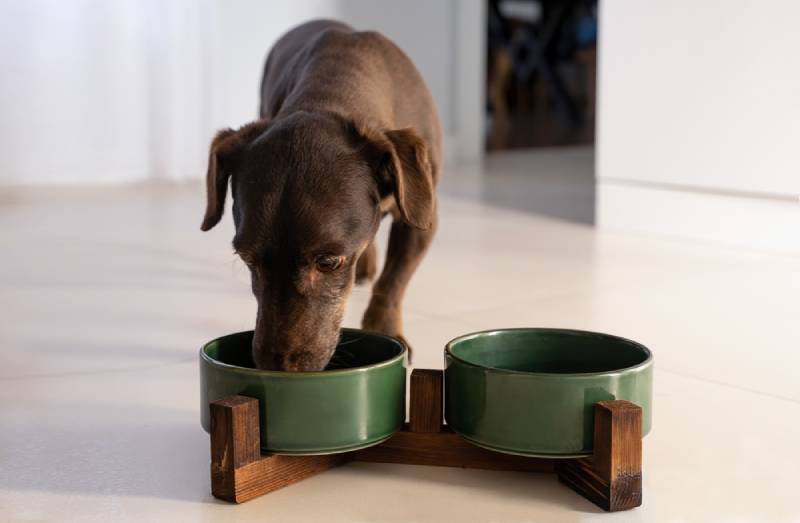
Click to Skip Ahead
Tilapia is the name given to a group of fish caught in different areas. While they are native to Africa and the Middle East, many countries farm them worldwide. That is why it’s so easy to find! Tilapia is a healthy protein source for dogs and is safe for them to eat, provided it’s prepared for them properly. In this article, we’ll look at why dogs can eat Tilapia, what benefits the fish brings, and how to prepare it for them safely.
Can Dogs Eat Tilapia?
Tilapia is a healthy and nutritious treat for dogs who can eat it. Most healthy dogs can have cooked Tilapia as a boost of low-fat protein; fish provides key nutrients and is a great option for dogs on a diet! As long as Tilapia is safely prepared, the fish is a tasty treat. Remember to always run any new foods by your vet before indulging your dog, and start by giving them a small amount at first.

Nutrition and Benefits of Tilapia
Like most fish, Tilapia is a great source of several important vitamins and minerals for your dog. It isn’t an oily fish, and the fat content is kept low. A portion of Tilapia can help provide your dog with vitamins D and B12, selenium, and phosphorus.
Vitamin D
Vitamin D is important for dogs as it helps them regulate the absorption rate and use of calcium and phosphorus in the body. This balance is very important, particularly for older dogs; osteodystrophy (the malformation of bones) can occur in dogs of any age, but older dogs can suffer from depleted calcium in their bones (brittle bone disease), which causes lots of problems. Tilapia contains 3.7 micrograms of vitamin D per 100 grams.
Selenium
Selenium is a mineral that plays an important role in your dog’s body. Selenium is involved in many processes, including reproduction, DNA synthesis, thyroid function, and even as a valuable antioxidant. Tilapia contains 54.4 micrograms of selenium per 100 grams.

Vitamin B12
Vitamin B12 (or cobalamin) is another vitamin that dogs can’t form in their bodies. Dogs need to supplement B12 through their diet, as it is used in the correct functioning of the brain, nervous system, and red blood cells. Deficiencies in B12 are often caused by malabsorption through the digestive system or poor diet, and signs of B12 deficiency can include:
A 100-gram portion of Tilapia contains 1.86 micrograms of vitamin B12.
Phosphorus
Phosphorus is an essential mineral used in combination and balanced with calcium and vitamin D in the body. Phosphorus helps maintain cell energy, cell structure, and works with calcium to keep bones strong and healthy. Phosphorus is primarily stored in bones but can also be found in the blood.
Because of the relationship between phosphorus and calcium, too much calcium can cause too little phosphorus (and vice versa); a balance is important! Tilapia contains a decent amount of phosphorus, at 204 milligrams per 100 grams.

Where Tilapia Is Raised
Because of how Tilapia is farmed, there are differences in taste, texture, and nutritional value. For example, some fisheries may have less control over certain types of algae that can exist in the water.
These can give the fish a “muddy” taste that some dogs might not like! However, the fish is usually very mild tasting. Tilapia raised in Ecuador and Peru are also recommended as “greener” and healthier by the Monterey Bay Aquarium Seafood Watch Program.
Frequently Asked Questions
How Do I Safely Prepare Tilapia for My Dog?
Preparing Tilapia for your dog is the same as how you prepare any other fish. First, the Tilapia should be thoroughly cleaned and deboned if buying fresh, but deboned fillets are easier to prepare.
Ensure only skinless and boneless fillets are given to your dog, and don’t include the head, fins, or tail, as they present a choking hazard and risk of perforation injuries. Most importantly, ensure that the Tilapia is fully cooked!
Undercooked fish presents a real danger to your dog’s health since bacteria such as salmonella or clostridium can flourish and make them sick. Parasites and their eggs can also live in the flesh and on the skin of undercooked or raw fish, so thorough cooking is always advised.

How Much Tilapia Can a Dog Eat?
The amount of Tilapia that’s healthy for your dog to eat will depend on their lifestyle, breed, and health conditions. Your vet can guide you on how much Tilapia would be appropriate to feed your dog (if any), but portions will generally be on the smaller side and given once or twice a week as a treat.
Which Fish Should Dogs Avoid?
Certain types of fish are unsuitable for dogs, mainly because of the food they eat and the size they grow before being harvested. Fish such as Swordfish, King Mackerel, Shark, or Tilefish are usually very high in mercury; mercury is a heavy metal that accumulates in the fishes’ bodies as they grow.
Other fish are appropriate for dogs, providing health benefits (like Tilapia) without heightened risks. Fish such as Salmon, Cod, Whitefish, Flounder, and Catfish are appropriate for your dog as long as they are prepared safely!
Final Thoughts
Tilapia is a widely available, mild tasting fish that’s inexpensive and farmed worldwide. It can be safely eaten by your dog (if your vet gives you the go-ahead) and can provide critical nutrients such as phosphorus, selenium, and vitamins B12 and D. Tilapia can be safely prepared for your dog by removing the head, tail, and skin, fins, and bones, and cooked thoroughly. Lastly, if you want to incorporate Tilapia (or any dog-friendly fish) into your dog’s diet, consult your vet first to ensure their nutritional needs are met.
Featured Image Credit: TonKhnthai, Shutterstock








